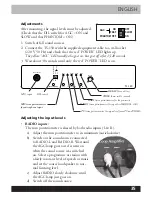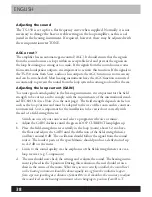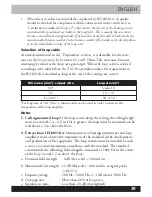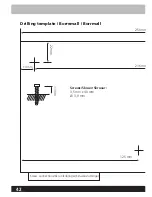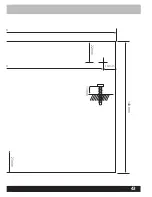
39
Selection of loop cable
As already mentioned in the ”Preparation” section, it is desirable for the resis-
tance in the loop wire to be between 0.5 and 1 Ohm. This resistance becomes
increasingly critical as the loop area gets larger. When the loop cable is selected
according to the table below, the TS-150 normally satisfies the requirement in
the IEC60118-4 standard as long as the rest of the settings are correct.
Wire area (mm
2
), copper wire
Loop area (m
2
)
0.25
Under 10
0.5
10 – 50
1 or 0.25 *
50 – 150
*For loop area of 50-150 m
2
, a thinner cable can be used in order to decrease the
temperature of the loop amplifier
Notes
1. Ceiling-mounted loop: If the loop is run along the ceiling, the ceiling height
must not exceed 2.4 – 2.6 m. If it is greater, the loop must be mounted on the
wall about 2.5 m above the floor.
2. Extract from IEC60118-4: Manufacturers of hearing instruments and loop
amplifiers must observe the requirement of the standard in the development
and production of the equipment. The loop system must be installed in such
a way as to ensure maximum compliance with the standard. The standard
recommends the following field strengths, measured at 1000 Hz in the centre
of the loop (room) 1.2 m above the floor:
a. Nominal field strength : 0 dB (flat scale) = 100 mA/m.
b. Maximum field strength : 12 dB (flat scale) = 400 mA/m. at signal peaks
(<0,125 s).
c. Frequency range
: 100 Hz – 5000 Hz +/- 3 dB relative 1000 Hz.
d. Coverage area
: More than 80% of loop area.
e. Signal/noise ratio
: Less than -20 dB (A-weighted).
e. When the system has been installed as stipulated by IEC60118-4, its quality
should be checked for compliance with the values noted in the certificate (see
“Certificate for inductive loop”). For best results, the telecoil of the hearing instru-
ment should be positioned vertically in the loop field. This is usually the case when
the user sits and looks straight ahead. If he leans his head forwards or backwards, the
sound usually becomes weaker. It also becomes weaker if he stands or sits directly above
or in the immediate vicinity of the loop wire.
ENGLISH











